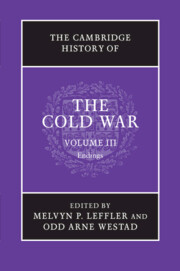Book contents
- Frontmatter
- 1 The Cold War and the intellectual history of the late twentieth century
- 2 The world economy and the Cold War, 1970–1990
- 3 The rise and fall of Eurocommunism
- 4 The Cold War and Jimmy Carter
- 5 Soviet foreign policy from détente to Gorbachev, 1975–1985
- 6 Islamism, the Iranian revolution, and the Soviet invasion of Afghanistan
- 7 The collapse of superpower détente, 1975–1980
- 8 Japan and the Cold War, 1960–1991
- 9 China and the Cold War after Mao
- 10 The Cold War in Central America, 1975–1991
- 11 The Cold War and southern Africa, 1976–1990
- 12 The Gorbachev revolution and the end of the Cold War
- 13 US foreign policy under Reagan and Bush
- 14 Western Europe and the end of the Cold War, 1979–1989
- 15 The East European revolutions of 1989
- 16 The unification of Germany, 1985–1991
- 17 The collapse of the Soviet Union, 1990–1991
- 18 Science, technology, and the Cold War
- 19 Transnational organizations and the Cold War
- 20 The biosphere and the Cold War
- 21 The Cold War and human rights
- 22 The Cold War in the longue durée: global migration, public health, and population control
- 23 Consumer capitalism and the end of the Cold War
- 24 An ‘incredibly swift transition’: reflections on the end of the Cold War
- 25 The restructuring of the international system after the Cold War
- Bibliographical essay
- Index
- References
5 - Soviet foreign policy from détente to Gorbachev, 1975–1985
Published online by Cambridge University Press: 28 September 2010
- Frontmatter
- 1 The Cold War and the intellectual history of the late twentieth century
- 2 The world economy and the Cold War, 1970–1990
- 3 The rise and fall of Eurocommunism
- 4 The Cold War and Jimmy Carter
- 5 Soviet foreign policy from détente to Gorbachev, 1975–1985
- 6 Islamism, the Iranian revolution, and the Soviet invasion of Afghanistan
- 7 The collapse of superpower détente, 1975–1980
- 8 Japan and the Cold War, 1960–1991
- 9 China and the Cold War after Mao
- 10 The Cold War in Central America, 1975–1991
- 11 The Cold War and southern Africa, 1976–1990
- 12 The Gorbachev revolution and the end of the Cold War
- 13 US foreign policy under Reagan and Bush
- 14 Western Europe and the end of the Cold War, 1979–1989
- 15 The East European revolutions of 1989
- 16 The unification of Germany, 1985–1991
- 17 The collapse of the Soviet Union, 1990–1991
- 18 Science, technology, and the Cold War
- 19 Transnational organizations and the Cold War
- 20 The biosphere and the Cold War
- 21 The Cold War and human rights
- 22 The Cold War in the longue durée: global migration, public health, and population control
- 23 Consumer capitalism and the end of the Cold War
- 24 An ‘incredibly swift transition’: reflections on the end of the Cold War
- 25 The restructuring of the international system after the Cold War
- Bibliographical essay
- Index
- References
Summary
Soviet international behavior in the decade before Mikhail Gorbachev’s perestroika is still an understudied and highly controversial topic. Some authors have long argued that the Soviet Union was greatly interested in détente in Europe, while neoconservative critics claimed that the USSR masterfully used détente in its quest for inexorable expansion and military superiority. At the time, Aleksandr Solzhenitsyn and most Soviet dissidents energetically supported the latter view.
Critics of détente made some excellent points. Soviet power reached its pinnacle in the late 1970s. Military expenditures, after rapid increases in the previous decades, stabilized at a high level. Three-fourths of all the research and development (R&D) potential of the country was located within the military-industrial complex. There were forty-seven “closed cities” with 1.5 million inhabitants, where military R&D labs and nuclear reactors were located, under the jurisdiction of the Atomic Ministry and the Ministry of Defense. The Politburo and General Secretary Leonid Brezhnev himself rarely argued with the decisions and programs of the Military-Industrial Commission. In April 1976, after the death of Andrei Grechko, the former head of this commission, Dmitrii Ustinov, became the minister of defense. In 1976, the Soviet military began to deploy the Pioneer – which the North Atlantic Treaty Organization (NATO) called the SS–20 – the new mobile, accurate, medium-range missile system carrying three warheads. Some experts had asserted that by the end of the 1970s the Soviet military would begin to surpass the United States in numbers of both missiles and nuclear warheads.
- Type
- Chapter
- Information
- The Cambridge History of the Cold War , pp. 89 - 111Publisher: Cambridge University PressPrint publication year: 2010
References
- 1
- Cited by

